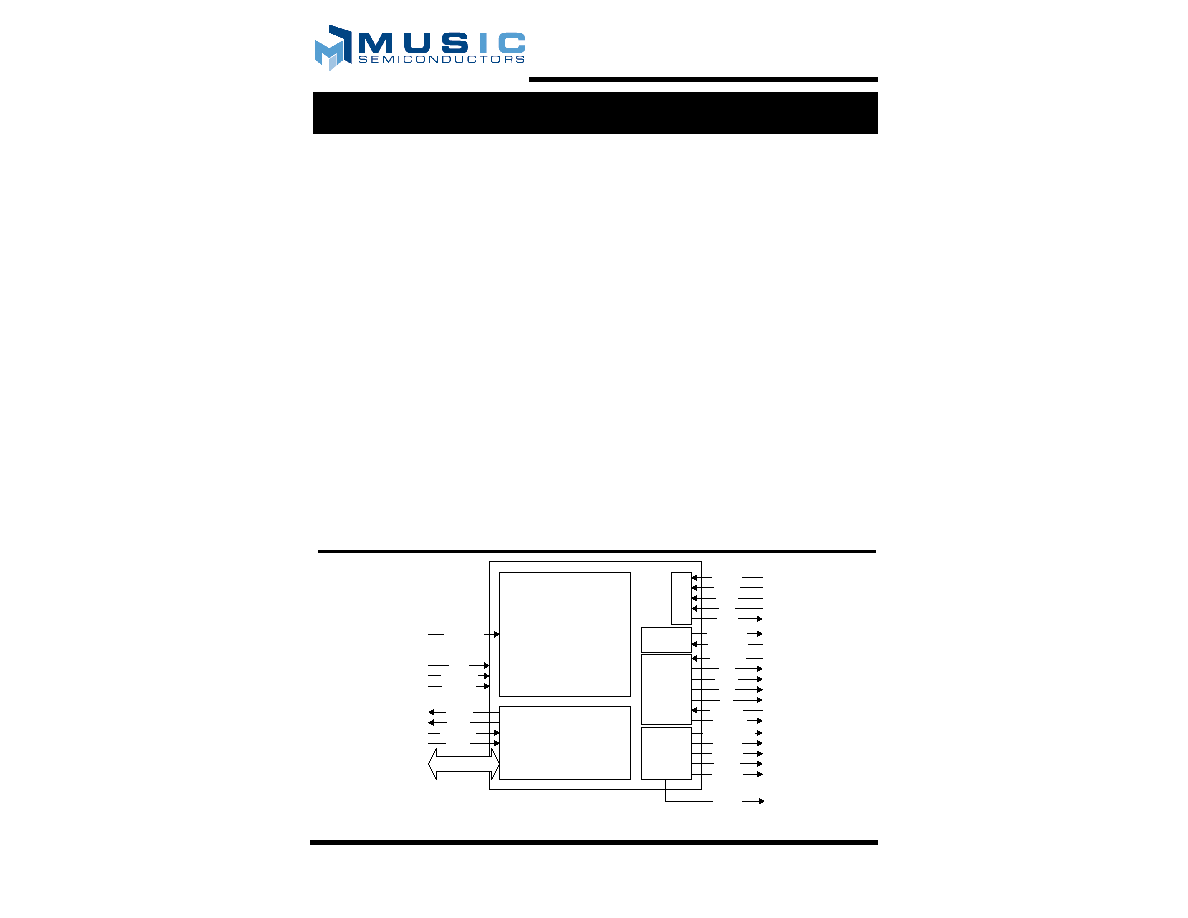
Advance Information
086,& 6HPL.RQGX.WRUV WKH 086,& ORJR DQG WKH SKUDVH 086,& 6HPL.RQGX.WRUV DUH
$SULO 5HY D
5HJLVWHUHG WUDGHPDUNV RI 086,& 6HPL.RQGX.WRUV 086,& LV D WUDGHPDUN RI
086,& 6HPL.RQGX.WRUV
*(1(5$/ '(6&5,37,21
The MUAD "Harmony" Ternary CAM is a fast look-up
table device supporting ternary (0, 1, don't care) elements
for networking and communication applications. Harmony
is a member of MUSIC Semiconductors RouteCAM
family.
The organization of the Harmony 2M part is 16K x 136
bits, and the 1M part is 8K x 136-bit wide, with
double-word and half-word options.
Harmony is ideally suited for high-speed, high-capacity
functions, including Ethernet and IP address search, data
compression, pattern recognition, cache tags,
high-bandwidth address filtering, and fast routing search
tables. These functions also include privileged, secured, or
encrypted packet-by-packet information utilized in
high-performance Internet equipment such as switches,
firewalls, bridges, and routers.
The flexibility of the Harmony device allows the creation
of multiple search tables within the same device. It
compares, simultaneously, the desired information (data)
against an entire, pre-stored, array of addresses, providing
a performance advantage by reducing search times an
order-of-magnitude over typical binary or tree-based
search algorithms. The Harmony device can be designed
into many applications, but it is particularly well suited to
perform highly intensive search operations.
)($785(6
�
16K and 8K x 136-bit full ternary CAMs
�
Configurable as 8K/4K x 272 or 32K/16K x 68
�
68-bit interface operates at 13.6Gbit/sec
�
Sustains 100 million searches per second on a 68-bit
or 136-bit field
�
50 million searches per second in 272-bit
configuration
�
Holds multiple word widths within the same device
�
Synchronous pipelined operation
�
Up to eight CAMs cascadable without performance
degradation or additional logic
�
Glueless interface to industry-standard synchronous
SRAMs
�
Supports IEEE 1149.1 Test Access
�
1.8 and 3.3V power supply
�
272-pin BGA package
+DUPRQ\ %OR.N 'LDJUDP
Controller
CAM
CLK
JTAG
TCLK
TMS
TDI
TDO
OP[8:0]
DQ[67:0]
Cascade
/SEN[3:0]
High-Speed
Interface
SRAM
Interface
SADR[21:0]
PHASE
OPV
CSI[6:0]
CSO[1:0]
MF
MV
FF
UID[4:0]
SCLK
/TRST
/OE
/WE
/CE
/ALE
/RST
FO[1:0]
FI[6:0]
/MM
/ACK
EOT
MUAD "Harmony" 2M and 1M Ternary CAMs
MUAD "Harmony" 2M and 1M Ternary CAMs
MUAD "Harmony" 2M and 1M Ternary CAMs
MUAD "Harmony" 2M and 1M Ternary CAMs

i
%DOO 'HV.ULSWLRQV
)XQ.WLRQDO 'HV.ULSWLRQ
&RQWHQW $GGUHVVDEOH 0HPRU\
7KH ,2 ,QWHUID.H
65$0 ,QWHUID.H
65$0 $GGUHVVLQJ
,QVWUX.WLRQ %XV DQG '4 %XV
'XDO 'DWD 5DWH &OR.N
&DV.DGH &RQWURO
3RZHU 0DQDJHPHQW
7HVW $..HVV 3RUW
,QLWLDOL]DWLRQ
'HSWK&DV.DGLQJ
$UELWUDWLRQ
6HDU.K ELW &RQILJXUDWLRQ ZLWK /&$0
6HDU.K ELW &RQILJXUDWLRQ ZLWK /5$0
'HSWK&DV.DGLQJ WR *HQHUDWH )XOO
+DUPRQ\ 7DEOH &RQILJXUDWLRQ
0XOWLSOH 6HDU.K 7DEOH &RQILJXUDWLRQ
0XOWLSOH /RJL.DO 7DEOHV RI 'LIIHUHQW :LGWKV
'HSWK &DV.DGLQJ WR &UHDWH /DUJHU /RJL.DO 7DEOHV
5HJLVWHU 'HV.ULSWLRQV
&RPSDUDQG 5HJLVWHUV
*OREDO 0DVN 5HJLVWHUV
5HVXOW 5HJLVWHUV
,QVWUX.WLRQ 5HJLVWHU
,QIRUPDWLRQ 5HJLVWHU
%XUVW 5HDG $GGUHVV 5HJLVWHU
%XUVW :ULWH $GGUHVV 5HJLVWHU
1H[W )UHH $GGUHVV 5HJLVWHU
&RQILJXUDWLRQ 5HJLVWHU
+DUPRQ\ ,QVWUX.WLRQV
,QVWUX.WLRQ &RGHV
,QVWUX.WLRQV DQG ,QVWUX.WLRQ 3DUDPHWHUV
5($' ,QVWUX.WLRQ
6,1*/( 5($' ,QVWUX.WLRQ
%8567 5($' ,QVWUX.WLRQ
:5,7( ,QVWUX.WLRQ
6,1*/( :5,7( ,QVWUX.WLRQ
%8567 :5,7( ,QVWUX.WLRQ
6($5&+ ,QVWUX.WLRQV
)XOO :RUG 6HDU.KHV
+DOI:RUG 6HDU.KHV
'RXEOH:RUG 6HDU.KHV
:ULWH 1H[W )UHH $GGUHVV
65$0 $GGUHVVLQJ
65$0 5($' RU :5,7( $..HVVHV
65$0 5($'
65$0 :5,7(
$SSOL.DWLRQ ,QIRUPDWLRQ
%LW :RUG $SSOL.DWLRQV
7LPLQJ 'LDJUDPV
&217(176

&RQWHQWV
08$' +DUPRQ\ 0 DQG 0 7HUQDU\ &$0V
LL
6LQJOH /R.DWLRQ 5HDG 7LPLQJ 'LDJUDP
:ULWH &\.OH 7LPLQJ 'LDJUDP
'DWD DQG 0DVN 5($' %/(1 IRU D *URXS RI &DV.DGHG 'HYL.HV 7LPLQJ 'LDJUDP
'DWD DQG 0DVN :5,7( %/(1 IRU D *URXS RI &DV.DGHG 'HYL.HV 7LPLQJ 'LDJUDP
%LW 6($5&+ 2SHUDWLRQ 7LPLQJ 'LDJUDP
%LW 6($5&+ 2SHUDWLRQ 7LPLQJ 'LDJUDP
%LW 6($5&+ 2SHUDWLRQ 7LPLQJ 'LDJUDP
$UELWUDWLRQ IRU D *URXS RI &DV.DGHG 'HYL.HV 7LPLQJ 'LDJUDP
:5,7( 7LPLQJ 'LDJUDP
65$0 5($' &\.OH 7LPLQJ 'LDJUDP
65$0 :5,7( &\.OH 7,PLQJ 'LDJUDP
$& 7LPLQJ :DYHIRUPV
(OH.WUL.DO 6SH.LIL.DWLRQV
(OH.WUL.DO &KDUD.WHULVWL.V
&DSD.LWDQ.H
2SHUDWLQJ &RQGLWLRQV
3D.NDJH
3LQ %*$ 'LPHQVLRQV
2UGHULQJ




